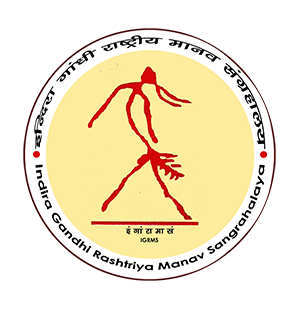मेक्किकट्टू: भूता मूर्तियों का स्थान
कलाकार: श्री कृष्ण गुडियागर, श्री रत्नाकर गुडीगर और श्री सुकुमार गुडीगर
क्षेत्र: उडुपी कर्नाटक
मेक्किकट्टू वह स्थान होता है जहां भूतों (आत्माओं) का प्रतिनिधित्व करने वाली मूर्तियों को एक निर्दिष्ट स्थान पर एकत्रित किया जाता है। भूता पंथ को ईश्वरीय आत्माओं व उपदेवताओं के रूप में माना जाता है। जैसा कि आत्माओं में अनिष्टकारी और परोपकारी दोनों पहलू होते हैं और माना जाता है कि वे मानव स्वास्थ्य, प्रजनन क्षमता एवं भाग्य, भूमि और मवेशियों पर अधिकार रखते हैं, उनका प्रचार होना चाहिए। प्रत्येक आत्मा का अपना रूप, पौराणिक इतिहास, विशेष शक्तियाँ और भविष्यवाणियाँ होती हैं। मूलरूप से मेक्किकट्टू कर्नाटक के उडुपी जिले में एक छोटी सी जगह है, जिसे मुख्य रूप से भगवान शिव के वाहन नंदिकेश्वर के स्थान के रूप में जाना जाता है। इसमें कई तरह की लकड़ी की मूर्तियाॅ हैं, जो कि वैदिक देव-समूह, दिव्य पुरुषों एवं स्त्रियों की है। कई पौराणिक प्रसंग और मौखिक परम्पराएं हैं जो मेक्किकट्टू की आत्माओं के चमत्कार को दर्शाती हैं। दक्षिण कन्नड़ और कर्नाटक के तटीय क्षेत्रों में बसे सभी जाति समूह के बीच भूता पंथ की व्यापक रूप से पूजा की जाती है। मानव संग्रहालय के मेक्किकट्टू में 41 लकड़ी की मूर्तियाॅ शामिल हैं जिन्हें 2008 और 2010 में उडुपी, कर्नाटक के क्षेत्रीय दौरे के दौरान अधिग्रहित किया गया जो कि संग्रहालय के संग्रह का हिस्सा बना। लेकिन वर्ष 2017 में यह लकड़ी की मूर्तियाॅ मिथक वीथी मुक्ताकाष प्रदर्शनी में स्थापित की गयी। जिसमें पुरुष और महिला आकृतियाॅ, पशु आकृतियाॅ जैसे बैल (एकल और बहु-सिर वाले), बाघ, सूअर, घोड़े, बंदर, बकरे एवं पक्षी आकृतियाॅ और संयुक्त आकृतियाॅ शामिल हैं।लकड़ी की मूर्तियों को गुडीगर समुदाय द्वारा तैयार किया जाता है एवं माना जाता है कि यह समुदाय काफी समय पहले गोवा से पलायन कर कर्नाटक के तटीय क्षेत्रों में बस गया। इन मूर्तियों को कटहल की लकड़ी से बनाया जाता है और उनके चमकीले लाल, पीले और काले रंग इसकी विशेषता है जिन्हें मूल रूप से प्राकृतिक स्रोतों से प्राप्त किया जाता है। हालांकि आजकल प्राकृतिक रंगों की जगह सिंथेटिक रंगों का प्रयोग किया जा रहा है।अलंकृत नक्काशीदार लकड़ी की मूर्तियों के अलावा, भूतों का प्रतिनिधित्व कच्चे पत्थर, धातु के मुखौटे और अनुष्ठानिक वस्तुओं द्वारा भी किया जाता है। आत्मा की पूजा अक्सर एक मूर्ति के साथ नहीं की जाती है, लेकिन इसमें कई तरह के कार्यों और अनुष्ठानों के शानदार प्रभाव शामिल होते हैं, जिसमें लोक महाकाव्य या गाथाएं गाते हैं, जिन्हें पड्डन (आत्माओं पर कथात्मक गीत) कहा जाता है, आत्माओं के वश में आए पुजारियों द्वारा किये गए नृत्य, भव्य परिधान और मुखौटे पहनना,चमत्कार और वीरतापूर्ण प्रदर्शन करना, दिव्य भावना का संदेश देना और बीमारी के समय में गांव के विवादों को निपटाना आदि शामिल है।
MEKKIKATTU: THE SHRINE OF BHUTTA IDOLS
Artist: Shri Krishna Gudiagar, Shri Ratnakar Gudigar and Shri Sukumar Gudigar
Region: Udupi, Karnataka
Mekkikattu is regarded to be the place where idols representing bhuttas (the spirits) are congregated in a designated place. Bhutta cults are consider as the ethereal spirits or demi gods. As spirits have both malevolent and benevolent aspects and are believed to possess power over human health, fertility and fortune and over the land and cattle, they must be propitiated. Each spirit has its own form, mythic history, special powers and propitiatory requirements.
Originally Mekkikattu is a small hamlet in Udupi district of Karnataka mainly known as the seat of Lord Nandikesvara, the Vehicle of Lord Shiva. It houses a numerous wooden sculptures of deified male and female and divinities of Vedic pantheon. There are a number of mythological episodes and oral traditions reflecting the miracles of spirits of Mekkikattu. Bhutta cults are widely worshiped among all caste group in South Kannada and coastal areas of Karnataka. The mekkikattu at IGRMS comprises of 41 wooden images, acquired during field tour in 2008 and 2010 from Udupi, Karnataka and became part of IGRMS Reserve Collection. But the installation of these wooden idols at mythological trail open air exhibition was made in the year 2017. Human figures of male and female; animal figures of bull (single-headed and multi-headed), tiger, boar, horse, monkey, ram; bird figures and composite figures are installed.
The idols are crafted by Gudigars, acommunity of wood carver believed to migrate from Goa and settled in the coastal Karnataka region long ago. These idols are made out of jackfruit wood and are characterised by their bright red, yellow and black colour that were originally obtained from natural sources. Today however natural pigments are replaced by synthetic colour.
Apart from ornately carved wooden sculptures, the Bhuttas are also represented by crude stone, metal masks and ritual objects. Spirit worship is not often conducted with an icon but involves a number of actions and rituals of spectacular effects singing folk epics or ballads called Paddanas (narrative songs on spirits), dancing by priest-impersonators possessed by spirits, wearing gorgeous costumes and masks, performing miracles and heroic feats and delivering message of divine spirit, during the time of disease and settling village disputes etc.



